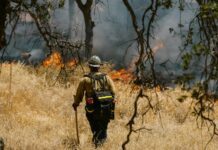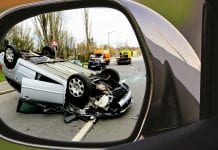Children typically get very excited when they see a new, fun-looking place to play, however, some innocent-looking playgrounds can be quite a hazardous place for your child. A playground presents the opportunity to create lifetime memories for children, but also contain dangers that could lead to bad memories and a trip to the doctor that no child looks forward to.
For instance, some local parks have fenced-in areas for dogs to run located near playgrounds. A small child could quickly walk the short distance, stick their hand or fingers through the fence and get bitten by a dog. A playground in a park may have ball fields nearby which may lack protective nets to protect viewers and bystanders from foul balls.
Making playground safety a priority can keep your children out of harm’s way, and build positive memories that will last them a lifetime. Below are ten playground hazards parents should be on the lookout for and tips to provide your child with the best experience!
1. Large Trees and Wind
Anytime there are large trees and wind there’s a chance a tree limb can fall from the tree and strike your child. The same is true with power lines, which can also deliver a lethal electrical shock. Don’t risk it. Take your child somewhere safe to play on a windy day.
2. Broken, Rusted, or Too Large Playground Equipment
Any equipment that isn’t in top form can pose a real danger to your child. Broken or rusted metal could have sharp edges that can cause a deep cut that would need stitches in the ER. Watch out for sharp bolts, screw ends or S hooks with an open end that can snag a child’s skin or clothing.
If there are guardrails on elevated surfaces of the playground equipment, check these for stability. Make sure that your child is not small enough to slip through the rails and fall.
It’s not safe to put a child that is too young or small on play equipment designed for an older, bigger child. Putting a three-year-old on a giant slide, for example, is not a good idea, because the child could easily topple off and get hurt. Even if a child begs to be allowed to go down that big slide, don’t give in to the pressure. Distract them with another safer activity.
3. Ground Hazards
Watch out for tripping hazards on the playground such as large rocks, exposed tree roots, or stumps that protrude from the ground. With toddlers, parents should scout around for such items as cigarette stubs, broken glass, aluminum cans with jagged metal, used syringes and needles, or discarded food lying on the ground.
Parents should be on the lookout for large fire ant hills, wasp or bee nests, or yellow jackets that have nested in the ground near play areas. If woods are nearby, don’t forget to check for the presence of snakes or wild animals.
4. Trash Cans
Be wary of trash receptacles where stinging insects may lurk. Keep an eye on younger children as they may feel tempted to take a swig from a half-empty soda can or nibble on a discarded pastry or candy.
5. Long Clothing, Scarves, or Necklaces
Long or overly large clothing can prove a safety hazard to children, especially on a playground where drawstrings or hoods can get caught on the play equipment and cause strangulation. Long scarves, necklaces, or anything that hangs around a child’s neck can also be dangerous. Hoodies may be fashionable, but these garments can cause serious accidents on a playground.
6. Roller Skating, Biking or Skateboarding
Some parks allow skateboarding and roller skating and may even have skateboard ramps for the older kids. Problems arise when parents of small children let them ride scooters or other wheeled toys down these large ramps. Many lawyers for children report that a small child is usually not capable of recognizing danger, so they beg to participate in potentially hazardous activities until eventually, the parent relents.
Older kids on skateboards, rollerblades, or roller skates can also carelessly run into smaller children, knocking them down and injuring them. Keeping small children well away from skateboarders, roller skaters, or bike riders in public parks and playgrounds can help keep them safe.
7. Frisbees, Boomerangs, and Drones
Lots of children like to throw frisbees, and boomerang-like toys and they are a lot of fun, but the enjoyment abruptly ends when someone gets hurt. If older kids are playing with these types of toys, keep your younger child out of the way to avoid accidental injuries, especially to the head and eyes.
Now that more people are flying drones realize these flying machines can pose a threat to a small child. It’s not a common occurrence, but drones can drop from the sky unexpectedly. If they strike a child, they could cause a severe injury.
8. Hard Surfaces
If a playground uses cement, asphalt, or gravel or other hard surfaces under playground equipment don’t allow your child to play there. Falling on such a surface can cause a very serious injury, such as broken bones, not to mention bruises and scrapes.
9. Fences Near a Busy Street
If the playground faces a street, make sure there is a sturdy fence with no breaks or holes where a child can slip through unnoticed and run into the street. Take the time to ensure your young child is safe and protected.
10. Bodies of Water
Parents should take special precautions if there is any form of water nearby. A small child can drown in just a few inches of water, so if there are creeks, small ponds, fountains, waterfalls or other forms of water without a fence around it, make sure to keep a close watch on your child.
Make Playground Safety A Priority
Many lawyers for children recommend instructing your child on the basics of playground safety at a young age and advise parents to always maintain proper supervision when young children are at play. Proactive awareness regarding these ten playground hazards is the best way to build great memories with your child. For more information, parents can obtain a Handbook for Playground Safety published by the US Consumer Product Safety Commission for more detailed information.
































